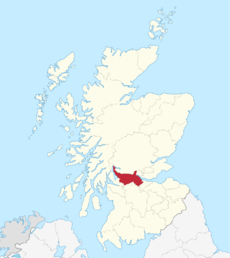| ||||||||||||||
| County of Stirling | |

| |
| Geography | |
| Area - Total |
Ranked 20th 286,338 acres (1159 km²) |
|---|---|
| County town | Stirling |
| Chapman code | STI |
Stirlingshire or the County of Stirling (Siorrachd Sruighlea in Gaelic) is a registration county of Scotland, based around Stirling, the former county town. It borders Perthshire to the north, Clackmannanshire and West Lothian to the east, Lanarkshire to the south, and Dunbartonshire to the south-west.
Until 1975 it was a county. Until the 1890s the county had two small exclaves: part of the parish of Logie, which was surrounded by Perthshire, and the parish of Alva, locally in Clackmannanshire. The Perthshire part of Logie was added to Stirlingshire, while Alva was annexed by Clackmannashire.
In 1975 most of Stirlingshire was included in the Central Region, with Kilsyth and surrounding area becoming part of Strathclyde Region. Since 1996 the area of the former county has been part of the council areas of East Dunbartonshire, Falkirk, North Lanarkshire and Stirling.
Coat of arms[]
The arms of Stirling County Council
The County Council of Stirling was granted a coat of arms by Lord Lyon King of Arms on September 29, 1890. The design of the arms commemorated the Scottish victory at the Battle of Bannockburn in the county. On the silver saltire on blue of St Andrew was placed the rampant red lion from the royal arms of Scotland. Around this were placed two caltraps and two spur-rowels recalling the use of the weapons against the English cavalry.[1]
On the abolition of the county council in 1975, the arms were regranted to Stirling District Council. They were regranted a second time in 1996 to the present Stirling Council, with the addition of supporters.
Subdivisions[]

Map of Stirlingshire in 1975, showing the position of burghs in the county.
Burghs[]
Until 1975 the county contained the following burghs:
- The Royal Burgh of Stirling (from the 12th century) (No. 2 on map)
- The Burgh of Bridge of Allan (a police burgh from 1870) (1)
- The Burgh of Denny and Dunipace (a police burgh from 1877) (4)
- The Burgh of Falkirk (a burgh of barony from 1600, reformed 1832) (5)
- The Burgh of Grangemouth (a police burgh from 1877) (6)
- The Burgh of Kilsyth (a burgh of barony from 1620, a police burgh from 1878) (3)
In 1930 Falkirk and Stirling became large burghs, taking over some of the duties of the county council. The remaining four burghs became "small burghs", with limited powers.

Civil parishes in Stirlingshire in use for local government until 1930.
Civil parishes[]
Following the boundary changes caused by the Local Government (Scotland) Act 1889, the county contained the following civil parishes:
|
In 1894 parish councils were established for the civil parishes, replacing the previous parochial boards. The parish councils were in turn replaced by district councils in 1930.
Districts[]
In 1930 the parishes ceased to be used for local government purposes, and the landward area of the county (the part outside the burghs) was divided into eight districts. These were abolished in 1975.[2]
- County of Stirling Central No.1
- County of Stirling Central No.2 (Denny, Dunipace and Kilsyth areas)
- County of Stirling Eastern No.1 (parishes of Airth and Larbert)
- County of Stirling Eastern No.2 (Falkirk and Slamannan)
- County of Stirling Eastern No.3 (parishes of Polmont and Muiravonside)
- County of Stirling Western No.1
- County of Stirling Western No.2
- County of Stirling Western No.3 (Baldernock, Campsie, Strathblane)
Parliamentary constituencies[]
Following the Act of Union, Stirlingshire returned members to the House of Commons of the Parliament of the United Kingdom from 1708.
1707 - 1918[]
- The Royal Burgh of Stirling formed part of the Stirling burghs constituency along with burghs in Fife and Perthshire.
- The Burgh of Falkirk formed part of Falkirk Burghs, along with burghs in Lanarkshire and Linlithgowshire.
- The remainder of the county returned a single member as the parliamentary county of Stirlingshire. The detached parish of Alva was annexed to the constituency of Clackmannanshire and Kinross by the Representation of the People (Scotland) Act 1832.
1918 - 1975[]
In 1918 seats in the House of Commons were redistributed. Stirlingshire was thereafter represented by three members of parliament.
- The burghs of Stirling, Falkirk and Grangemouth formed the Stirling and Falkirk burghs constituency. in 1974 the constituency was renamed Stirling, Falkirk and Grangemouth.
- The eastern part of the county (defined in 1948 and 1970 as the Eastern No.1, Eastern No.2 and Eastern No.3 Districts) was combined with Clackmannanshire to form Clackmannan and East Stirlingshire
- The remainder of the county was included in the constituency of West Stirlingshire (named Stirling and Clackmannan West until 1945). The area included in the constituency was defined in 1948 and 1970 as the burghs of Bridge of Allan, Denny and Dunipace and Kilsyth; and the Central No. 1, Central No. 2, Western No. 1, Western No. 2 and Western No. 3 districts.[3]
These boundaries continued in use until 1983, when new constituencies were formed based on the regions and districts created in 1975.
References[]
- ^ R.M. Urquhart, Scottish Burgh and County Heraldry, London, 1973
- ^ Stirlingshire, West Lothian and Central Region Finding Aid (Falkirk Council)
- ^ The Parliamentary Constituencies (Scotland) Order 1970 (S.I. 1970 No. 1680)
External links[]
- William Nimmo's The History of Stirlingshire at Electric Scotland
- Entry on Stirlingshire, from A Topographical Dictionary of Scotland by Samuel Lewis, London, 1846 (British History Online)
| ||||||||||||||||||
| This page uses content from the English language Wikipedia. The original content was at Stirlingshire. The list of authors can be seen in the page history. As with this Familypedia wiki, the content of Wikipedia is available under the Creative Commons License. |